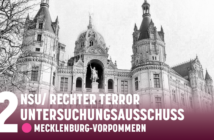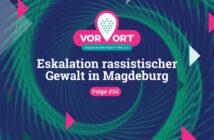Several very diverse weeks of trial have passed since our summary of the first four days of the trial on May 31. At this point we will try to structure and summarize the insights and impressions gained.
While the first days of the trial were devoted to the interrogation of the defendants Carsten S. and Holger G., the ensuing hearing of evidence on the various crime complexes was not very stringent and jumped between the questioning on various topics: Witnesses and experts were called with regard to the case of arson in Frühlingsstraße, officials with concern to the murder of Abdurrahim Özüdoğru and the identification of the weapon through Carsten S. and Holger G., as well as officials that had conducted quasi informal conversations with Beate Zschäpe.
New insights
During the trial, new insights were primarily gained from statements made by Carsten S. that he had never made before – neither during interrogations by the police nor during conversations with anti-fascists in Düsseldorf. These statements have yet to be verified, but offer new angles of inquiry and even provide new investigation leads that have to be pursued. Especially his previously withheld memory of allusions and boasts allegedly made by Mundlos and Böhnhardt during the delivery of the weapon in Chemnitz was spectacular: Supported by journalistic research, everything seems to indicate another attack carried out by the NSU on an inn run by a Turkish innkeeper in Nuremberg on June 23, 1999, using a pipe bomb in the form of a torch. [http://www.stern.de/blogs/nsu-prozess/weiterer-rohrbombenanschlag-auf-konto-des-nsu/] During the following press conference, representatives of the Federal Prosecutor General weren’t even able to say whether this attack had been one of the many unsolved cases reviewed after the NSU’s self-exposure. Meanwhile, the Federal Prosecutor’s Office has begun investigating the attack as part of a new case. Carsten S. has already been interrogated by the investigators accordingly.
Holger G. and in particular Carsten S. incriminated Ralf Wohlleben severely. Their statements lead to the conclusion that Wohlleben was a leading member of the NSU, rather than “just” a supporter. For instance, Carsten S. now also remembered that during a telephone conversation with those in hiding he had heard Wohlleben laugh and say that “they had shot someone”. Albeit rather haltingly, Carten S.’s questioning provided new insight into racist and neo-Nazi acts of violence and structures in Thuringia and thus contributed to an overview of the situation of the right-wing scene at the turn of the millennium. Moreover, according to his statements, there had been talk of “the three” in Thuringia’s right-wing scene. His description of an attack on supposed Nazi-opponents, during which Wohlleben allegedly “stamped on the face” of one of the victims, has led to a new criminal investigation against Wohlleben – on the grounds of attempted murder. Other statements of Carsten S. raise the still important question whether the secret service should have known about Mundlos, Zschäpe and Böhnhardt through confidential informers such as Tino Brandt and other (former) neo-Nazis.
Outside of the courtroom the news was made public on June 12 that Beate Zschäpe was maintaining contact by mail to the known neo-Nazi Robin Sch. [http://www.swr.de/blog/terrorismus/2013/06/12/brieffreundschaft-beate-zschape-gibt-tiefe-einblicke/]. Whether the confiscated letter of 26 pages will be used as evidence in the trial and the possible insights into her thoughts and social relationships will influence the evaluation of the NSU is still being fought over in court.
Impressions of the accused
Carsten S. was in tears when he apologised at the end of the questioning through the Accessory Prosecution: “I cannot imagine what kind of incredible suffering, injustice was inflicted on their relatives, their//- You as their families- words fail me.” Surprisingly, Carsten S. announced he would not be answering any of Ralf Wohlleben’s attorneys’ questions, as long as he didn’t testify himself. Yet as positive as the articulated and initiated attempt to “set things straight” and his willingness to answer the court’s questions are – the impression remains that he still isn’t giving away all he knows: He still has “memory gaps” when he might incriminate others (apart from Wohlleben) and where his own guilt might become apparent. Evasively, he circumnavigated the political classification of his deeds and his former – by all means significant – functions in the NPD and the JN. According to co-plaintiff attorney Alexander Hoffman, Carsten S. was styling himself as an “anti-racist within the NPD” (Report 12). Why hadn’t he come clean much earlier, and why was he supposedly left in peace by both the NSU and the officials after his exit from the scene? These and further questions have to be asked.
In contrast to the defendant Carsten S., Holger G. refused to be interviewed. A statement was read out, admitting to the accusation of supporting those in hiding, and severely incriminating the defendants Zschäpe and Wohlleben. However, he downplayed his own role. He also justified his deeds as sheer acts of friendship, whose fatal racist consequences he couldn’t have known.
The defendants Zschäpe, Wohlleben and André E. remained silent, as announced previously. The questioning of officials who had spoken to Zschäpe in various situations (not interrogations!) brought to light interesting insights into the silent defendant. In this way some of her self-incriminating statements were recorded. Especially interesting was the account of a detective chief superintendent of the BKA, who had spoken to Zschäpe about her alleged discontent with her attorney and her considerations to testify. Thus she supposedly said that she wasn’t “someone who doesn’t own up to their deeds”.
Federal Prosecutor’s Office vs. Accessory Prosecution
First of all, the Federal Prosecutor’s Office had to yield to the pressure exerted by the Accessory Prosecution and admitted on June 11 that there was an updated list of people in the environment surrounding the NSU: At the moment, the so-called 129-list includes around 500 people. However, the Prosecution downplayed the list’s importance. On various days of the trial they made very clear that the trial’s aim was not to clarify the environment of supporters – contrary to the interests of the relatives and the Accessory Prosecution. The Federal Prosecutor’s Office declared with regard to motions put forward by the co-plaintiffs that the “clarification of the NSU’s right-wing environment” was “not part of this main trial”. This had been brought about by co-plaintiff attorney Bliwier’s statement and application to produce evidence concerning the relations between the neo-Nazi-scenes in Dortmund and Kassel – particularly with regard to a meeting during a right-wing rock-concert in Kassel in 2006, where confidential informers of the secret service, Uwe Mundlos and Uwe Böhnhardt had allegedly been present.
The defending attorneys’ strategies
It was hardly surprising that Zschäpe’s defending attorneys objected to the use of statements of officials who had “chatted” with Zschäpe. Wohlleben’s attorneys Nicole Schneiders and Olaf Klemke (known to often defend members of the right-wing scene) requested their client’s release from custody – so far unsuccessfully. Moreover, they want to prevent the use of Carsten S.’s statements. While the defending attorneys of Carsten S. have shown themselves cooperative towards applications and questions of the court and the Accessory Prosecution, the attorneys of defendants Holger G. and André E. have hardly played a role so far.
The investigating authorities
The hearing of evidence that has begun in the case of the murder of Abdurrahim Özüdoğru, who was killed by two shots to the head in his tailor shop in Nuremberg on June 13, 2001, has given first insights into the occasionally racist prejudgments of the police. We already know this from the findings of the investigation committee concerned with the NSU: Even during the trial the testifying official could not get along without derogatory side remarks when referring to the victim.
In the hearing of evidence concerning the identification of the Ceska-gun that Carsten S. and Wohlleben allegedly passed on as the murder weapon, statements of police officials who had conducted the presentation of weapons were introduced. In doing so, they revealed especially the police’s chaotic investigation work: Carsten S. had first been shown poor black-and-white copies and at a later point models of different weapons. The hearing of evidence concerning the weapon’s identification by the alleged supporter Holger G. had been similarly chaotic: A police-witness who had been present during an interrogation of Holger G. and had presented the weapons to him was asked to reconstruct the scene with the weapons in the courtroom. As it turned out during the hearing, the weapons were of the same type that Holger G. had been shown – however they were not the same weapons, and possibly the weapons presented at the time had even had differently coloured barrels.
Conclusion and outlook
After the occasionally surprising statements made by Carsten S., it has become clear that the trial can indeed provide new insights and approaches of investigation. The Prosecution on the other hand has repeatedly made clear that it will limit the hearing of evidence to the offences the defendants are accused of, and not cover the full extent and environment of the NSU. Yet the Accessory Prosecution has still managed to advance its interests despite time pressure. Some days of the trial were rather lengthy, in particular due to motions and applications brought forward by the defending attorneys.
In the coming weeks, the trial will also not proceed in a stringent manner. The hearing of evidence regarding the case of arson in Frühlingsstraße will be continued, but the various cases of murder will also appear on the agenda.


